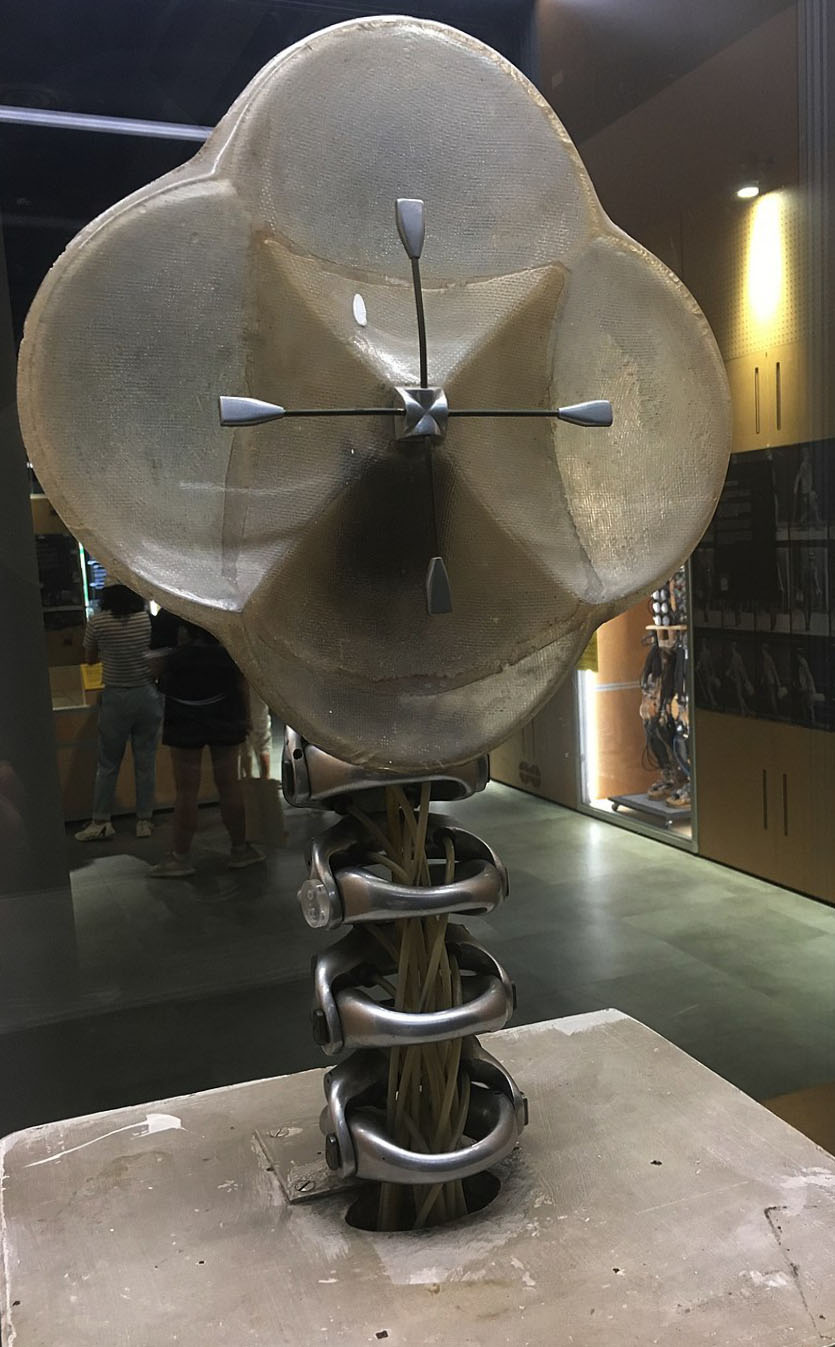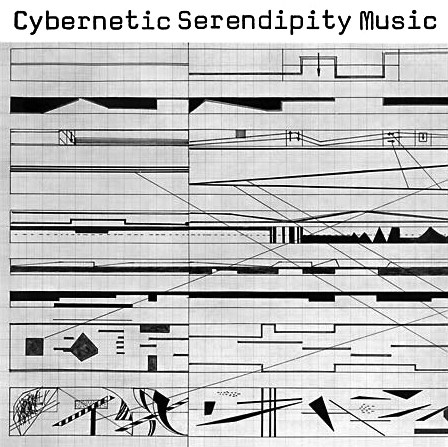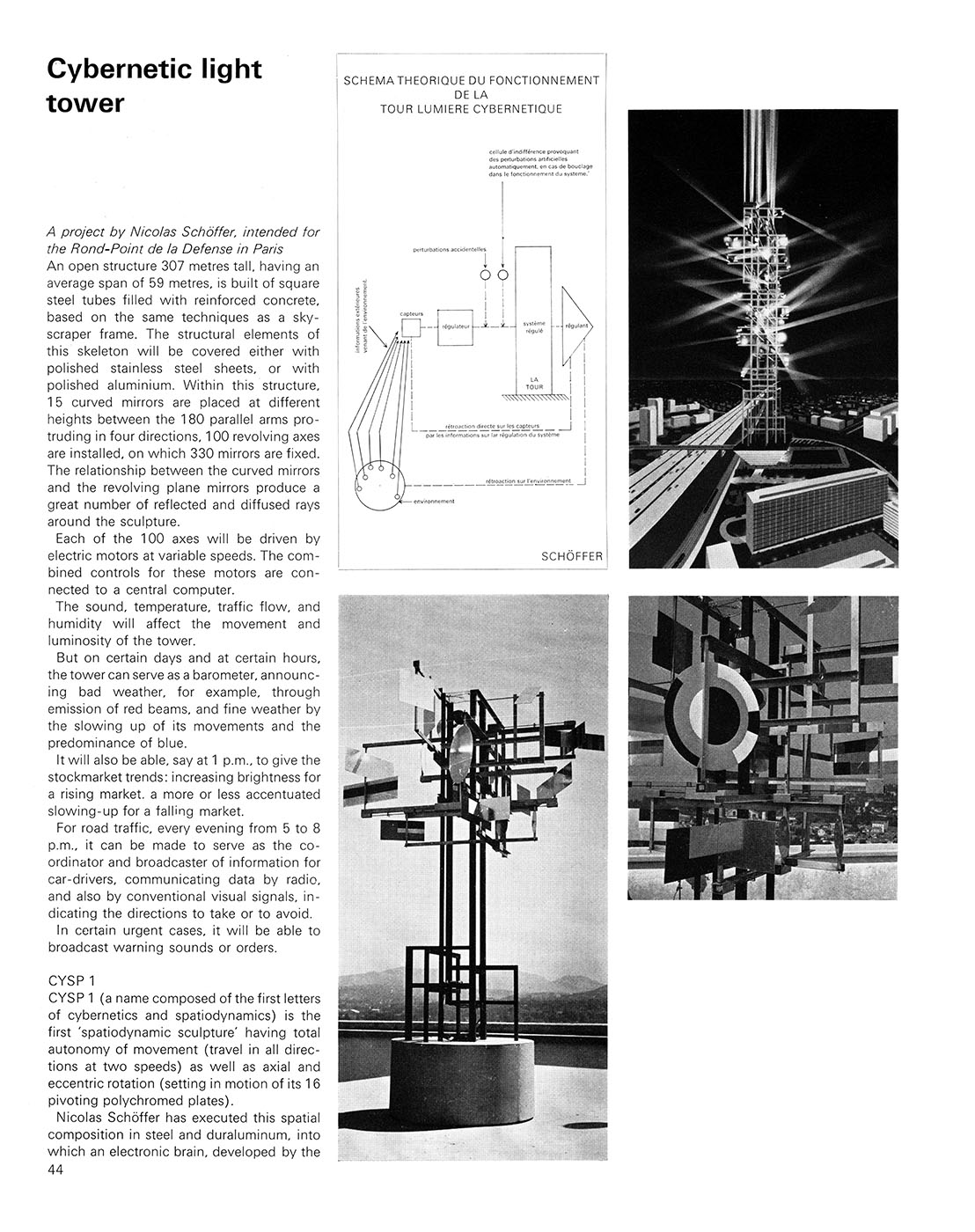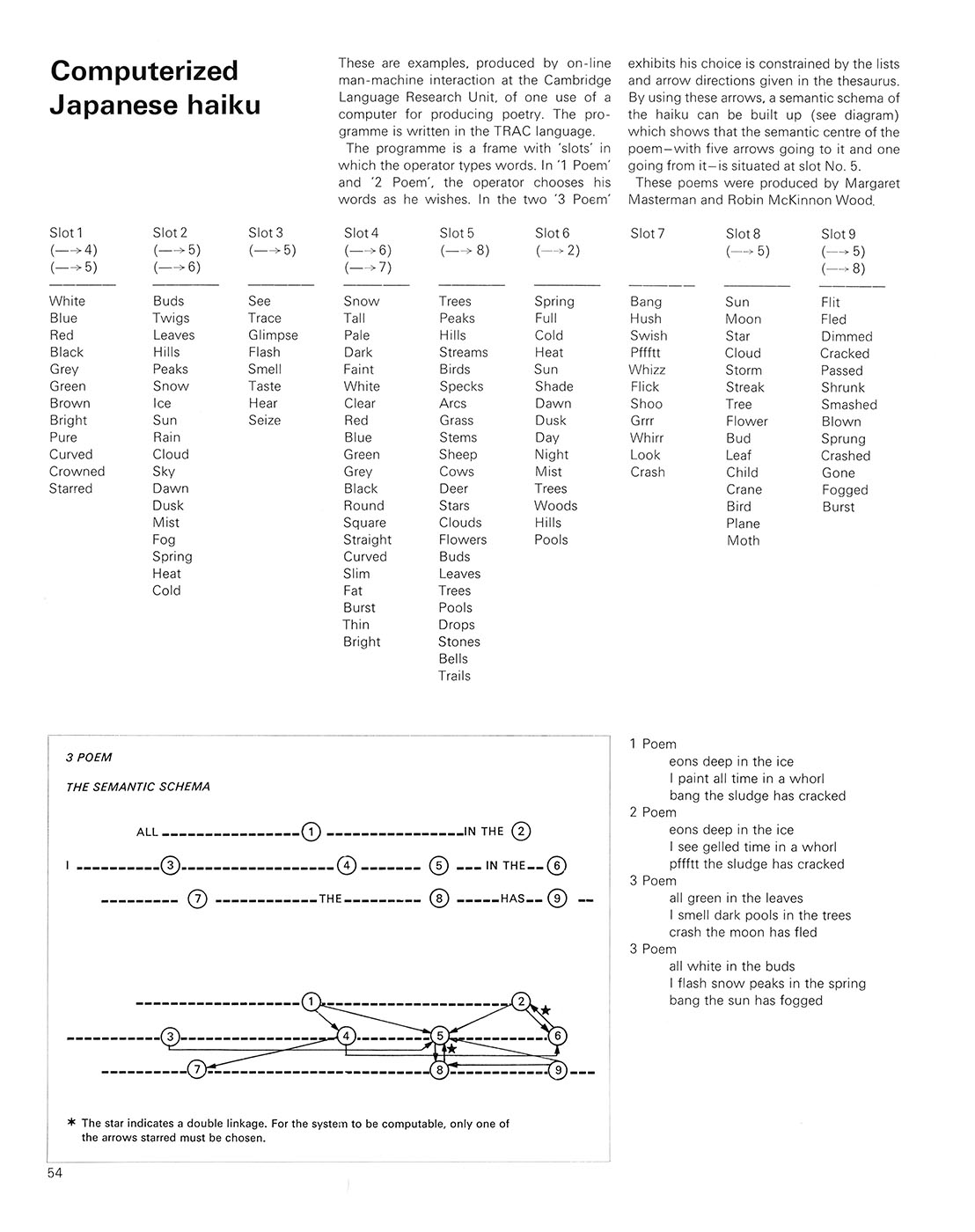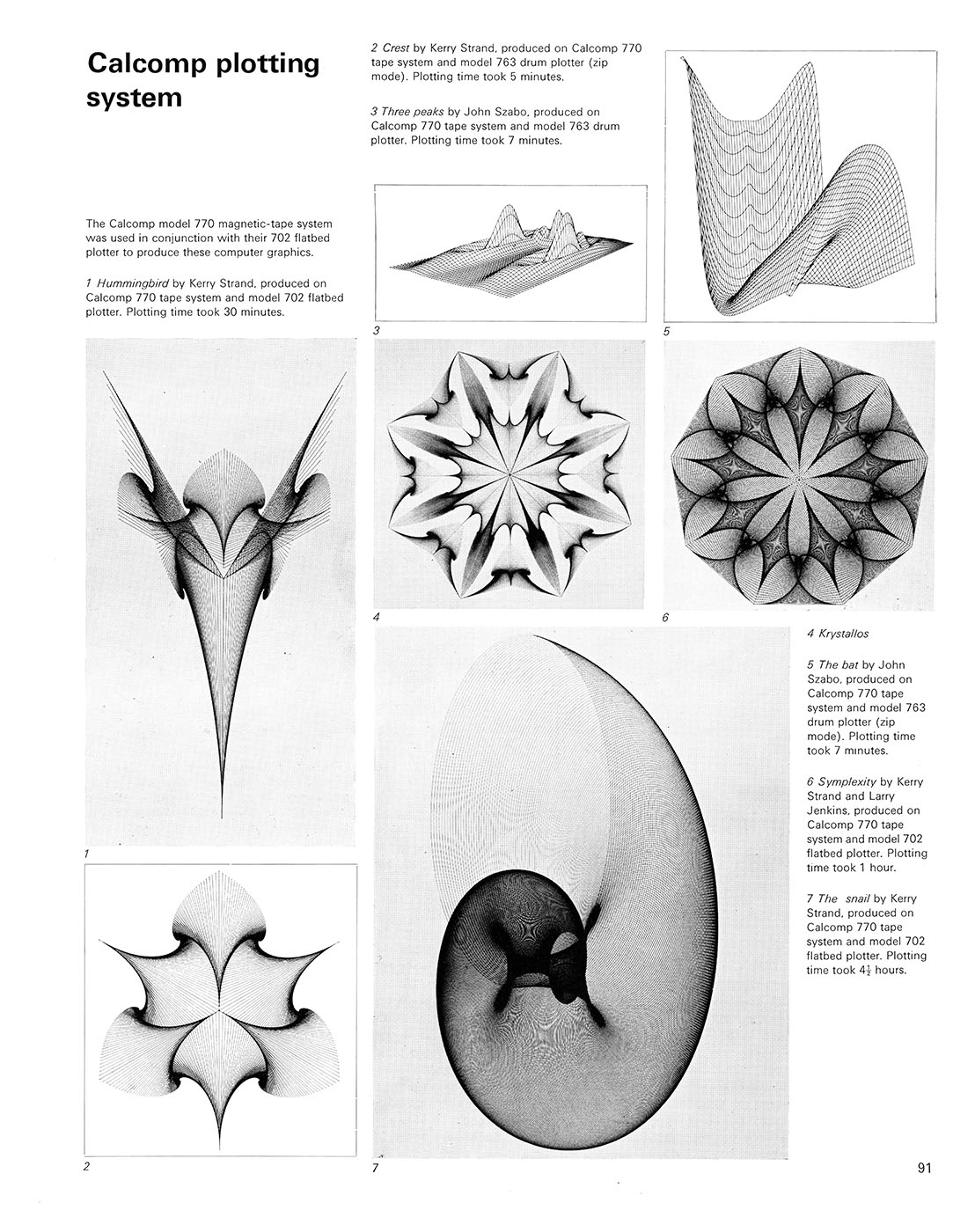‘Absolute power will corrupt not only men but machines’. In his article ‘Inventing the future’, Dennis Gabor put forward some of his expectations and fears about the function of the machine in society of the future. The above comment was made with reference to electronic predictors, which, having built up a reputation for accuracy, become aware of their infallibility (since they are learning machines) and begin to use their newly-discovered power.
So far electronic predictors have not become a reality. However, another postulation made by Professor Gabor in the same article (Encounter May 1960) appears to be very relevant indeed. Will the machine—he wondered-cut out the creative artist? ‘I sincerely hope’, Gabor continued, ‘that machines will never replace the creative artist, but in good conscience I cannot say that they never could.’
The computer performs various functions which in the broader sense seem to be the act of intelligence, i.e. manipulation of symbols, processing of information, obeying complex rules and even learning by experience. Nevertheless, the computer is not capable of making abstractions, and is devoid of the three prime forces behind creativity-imagination, intuition and emotion. Despite this, the computer as a budding artist has been making an appearance since about 1960. In 1963, the magazine Computers and Automation announced a computer art contest which has been held annually ever since. The winning design usually appears on the cover of the August issue and the runners-up are given a coverage inside. The designs vary considerably although they share certain characteristics, i.e. they are only in black and white, there is an emphasis on geometrical shapes, and they are basically linear. As designs, the computer products look bare and minimal and represent little else than the initial stage in what may be a far more challenging adventure in merging rather than relating creative activity with technology.
Computer graphics range from static compositions to frames of motion pictures, and could be divided into two main categories; 1. those which approximate to pure design or art; and 2. those which are not made with any aesthetic end in view but which serve to visualise complex physical phenomena.
At a conference dealing with computers and design in 1966 at the University of Waterloo, two statements were made which might at first have appeared unnecessarily boastful and heroic: 1. ‘The computer simply elevates the level of possible creative work’. 2. ‘The computer can handle some elements of creativity now-by current definitions of creativity’. Both these statements were made by scientists, although there exists a considerable scepticism amongst scientists as well as artists about the validity of the various experiments in this area. Others claim that the computer provides the first real possibility of a collaboration between the artist and the scientist which can only be based on each other’s familiarity with both media.
The first commercial computer was marketed in 1950. Ten years later the Boeing airplane company coined the term ‘computer graphics’. They used graphics for purely utilitarian purposes. These were employed, for instance, to verify the landing accuracy of a plane viewed from the pilot’s seat and the runway. They were used to establish the interaction of range of movements of the pilot in his environment of the cockpit. To this end they created a 50 percentile pilot and studied him in animation. All the drawings and the animation were done with a computer. Other experiments included visualising acoustic graphs in perspective and the production of very accurate isometric views of aeroplanes.
There are two main methods at present by which computer graphics are made. In the first place there are the ink drawings produced by a computer-driven plotter. The plotter, a moving pen, conveys the image direct to paper. Drawings can also be made with the images composed of different letters or figures and printed out on a typewriter which is automatically operated by the computer. In the second category are the computer graphics made on the cathode ray tube with an electron beam electrically deflected across the phosphorescent screen to produce the desired picture. A camera photographs the image in various stages and an electronic console is used to control the picture and to advance the film. Static graphics can be obtained by making enlarged photographs from the film. Whether the pictures are made for analytical purposes or just for fun, the computer graphic is a visual analogue to a sequence of calculations fed into the computer.
The now ‘antique’ Sketchpad which has been used for numerous experiments of this type at Massachusetts Institute of Technology since 1962, was one of the first to produce drawings on a cathode ray tube demonstrating the sort of possibilities which are inherent in the system. One could draw with a light pen on the screen simple patterns consisting of lines and curves. The operator could impose certain constrictions on the patterns he was making by demanding, for instance, by pushing the appropriate button, that the lines be made parallel, vertical or straight. At that stage the operator could not demand something as complex as a solution to the following problems: ‘These lines represent a piece of structure of a certain thickness and size and with certain cross-section characteristics, made of a particular material and obeying specific physical laws-depict this under a stress of so many pounds per cubic foot’.
Today the process whereby a design is adjusted at any stage of its development is already quite familiar. If the operator alters the design on the cathode ray tube with a light pen, the computer converts the altered design into electronic impulses using them to modify the pre-existing programme held in the computer’s memory store. The altered design then appears on another cathode ray tube. This system is widely used by General Motors for car body design. The image on the cathode ray tube can be shifted, rotated, enlarged, seen in perspective, stored, recalled and transferred to paper with the intermediate stages recorded on film. Since the process suggests inhibiting difficulties to someone who is not an electronic engineer, it may be difficult for an artist to imagine how he could possibly make use of a computer. The solution to the problem lies in collaboration. There are three stages in the process of producing computer graphics, or for that matter using the computer in most cases. In the first place the communicator presents his ideas or message which is to be communicated to the computer. Secondly, the communication specialist decides, unless there are specific instructions, whether the problem should be solved graphically, verbally or as a combination of both. Thirdly, the computer specialist selects the appropriate computer equipment and interprets the problem into machine language, so that the computer can act upon it. The Korean artist Nam June Paik has gone so far as to claim that in the same way that collage technique replaced oil paint, so the cathode ray tube will replace canvas. However, so far only three artists that I know of have actually produced computer graphics, the rest to date having been made by scientists.
At the moment the range of visual possibilities may not seem very extensive, since the computer is best used for rather more schematic and geometric forms, and those patterns and designs which are logically simple although they may look very intricate. One can programme the computer to produce patterns based on the golden section or any other specific premise, defining a set of parameters and leaving the various possibilities within them to chance. In this way certain limitations are provided within which the computer can ‘improvise’ and in the space of 20 minutes race through the entire visual potential inherent in the particular scheme. Programmed to draw variations with straight lines it is conceivable, though perhaps unlikely, that one of the graphics produced may consist simply of one line placed exactly on top of another. If there is no formula for predicting each number or step in a given sequence, the system by which this type of computer graphic comes about can be considered random.
Interesting results can be obtained by introducing different random elements into the programme. One can, for instance, produce a series of points on a surface which can be connected in any way with straight lines, or one can instruct the computer to draw solid geometric shapes without specifying in what sequence they are to be superimposed, leaving the overlapping of the shapes to chance.
A fascinating experiment was made by Michael Noll of the Bell Telephone Laboratories whereby he analysed a 1917 black-and-white, plus-and-minus picture by Mondrian and produced a number of random computer graphics using the same number of horizontal and vertical bars placed within an identical overall area. He reported that 59% of the people who were shown both the Mondrian and one of the computer versions preferred the latter, 28% identified the computer picture correctly, and 72% thought that the Mondrian was done by computer. The experiment is not involved either with proof or theory, it simply provides food for thought. Noll, who has produced a considerable number of computer graphics and animated films in America, sees them as a very initial stage in the possible relationship between the artist and computer. He does not consider himself as an artist by virtue of his graphic output. He sees himself as someone who is doing preliminary explorations in order to acquaint artists with these new possibilities.
Perhaps even less credible than the idea of computer-generated pictures is the idea of computer sculpture. That too has been achieved. A programme for a three-dimensional sculpture can be fed into a computer- the three-dimensional projection of a two-dimensional design. It can be transferred via punched paper tape to a milling machine which is capable of producing the physical object in three dimensions.
The computer is only a tool which, at the moment, still seems far removed from those polemic preoccupations which concern art. However, even now seen with all the prejudices of tradition and time, one cannot deny that the computer demonstrates a radical extension in art media and techniques. The possibilities inherent in the computer as a creative tool will do little to change those idioms of art which rely primarily on the dialogue between the artist, his ideas, and the canvas. They will, however, increase the scope of art and contribute to its diversity.
Jasia Reichardt


